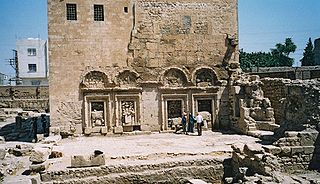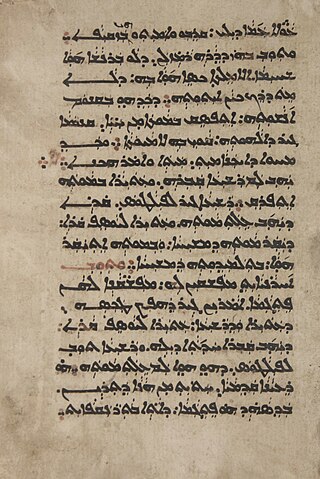Gregory Bar Hebraeus, known by his Syriac ancestral surname as Barebraya or Barebroyo, in Arabic sources by his kunya Abu'l-Faraj, and his Latinized name Abulpharagius in the Latin West, was a Maphrian of the Syriac Orthodox Church from 1264 to 1286. He was a prominent writer, who created various works in the fields of Christian theology, philosophy, history, linguistics, and poetry. For his contributions to the development of Syriac literature, has been praised as one of the most learned and versatile writers among Syriac Orthodox Christians.
The Book of the Bee is a historiographic and theological compilation, containing numerous Biblical stories. It was written around 1222, by Solomon of Akhlat, who was Bishop of Basra, within the Church of the East. It is written in the Syriac language.

The School of Nisibis was an educational establishment in Nisibis. It was an important spiritual centre of the early Church of the East, and like the Academy of Gondishapur, it is sometimes referred to as the world's first university. The school had three primary departments teaching: theology, philosophy and medicine. Its most famous teacher was Narsai, formerly head of the School of Edessa.

Henana of Adiabene was a Christian theologian, and headmaster of the School of Nisibis, the main theological center of the Church of the East (571–610).

The School of Edessa was a Christian theological school of great importance to the Syriac-speaking world. It had been founded as long ago as the 2nd century by the kings of the Abgar dynasty. In 363, Nisibis fell to the Persians, causing St. Ephrem the Syrian, accompanied by a number of teachers, to leave the School of Nisibis. They went to Edessa, where Ephrem took over the directorship of its school. Then, its importance grew still further. There were innumerable monasteries at Edessa housing many monks. Ephrem occupied a cell there, practicing the ascetic life, interpreting Holy Scripture, composing poetry and hymns and teaching in the school, as well as instructing young girls in church music.
Garshuni or Karshuni are Arabic writings using the Syriac alphabet. The word "Garshuni", derived from the word "grasha" which literally translates as "pulling", was used by George Kiraz to coin the term "garshunography", denoting the writing of one language in the script of another.
Jacob of Edessa was Bishop of Edessa and prominent Syriac Christian writer in Classical Syriac language, also known as one of earliest Syriac grammarians. In various works, he treated theological, liturgical, canonical, philosophical and historical subjects, and contributed significantly to scholarly and literary development of Syriac Christianity. He is considered to be one of the most important scholars of the Christian-Aramean tradition.
Bardaisan, known in Arabic as ibn Dayṣān and in Latin as Bardesanes, was a Syriac-speaking Assyrian Christian writer and teacher with a gnostic background, and founder of the Bardaisanites.

Syriac literature is literature in the Syriac language. It is a tradition going back to the Late Antiquity. It is strongly associated with Syriac Christianity.
Barḥadbshabba ʿArbaya was a teacher, historian and biblical commentator of the Church of the East.
Julian II, also known as Julian the Roman or Julian the Soldier, was the Patriarch of Antioch and head of the Syriac Orthodox Church from 687 until his death in 708.
The Acts of Shmona and of Gurya is a Syriac Christian martyrdom text. The setting takes place at Edessa during Roman Emperor Diocletian's Great Persecution.
Giwargis Warda was a Syriac poet of the Church of the East who probably lived in the 13th century. He is named in several manuscripts as the author of The Book of the Rose, an anthology of Syriac hymns for various liturgical festivals. Not all of the poems contained in this anthology are authored by him, but establishing the authenticity of the poems is difficult given the high degree of variation between manuscripts. Only 34 out of 150 poems attributed to him have been published so far.

Aramaic studies are scientific studies of the Aramaic languages and literature. As a specific field within Semitic studies, Aramaic studies are closely related to similar disciplines, like Hebraic studies and Arabic studies.
Qenneshre was a large West Syriac monastery between the 6th and 13th centuries. It was a centre for the study of ancient Greek literature and the Greek Fathers, and through its Syriac translations it transmitted Greek works to the Islamic world. It was "the most important intellectual centre of the Syriac Orthodox ... from the 6th to the early 9th century", when it was sacked and went into decline.
John the Stylite, also known as John of Litharb, was a Syriac Orthodox monk and author. He was a stylite attached to the monastery of Atarib and part of a circle of Syriac intellectuals active in northern Syria under the Umayyad dynasty.
Elishaʿ bar Quzbaye (fl. c. 450 – c. 510/530) was a hermeneut and apologist of the Church of the East. Active in Persia, he served as the second or third director of the school of Nisibis. He wrote extensively in Syriac, but only a few fragments of his works survive.
Job of Edessa, called the Spotted, was a Christian natural philosopher and physician active in Baghdad and Khurāsān under the Abbasid Caliphate. He played an important role in transmitting Greek science to the Islamic world through his translations into Syriac.
David was a monk, bishop and historian of the Church of the East in the 7th or 8th century.

Yoḥannan bar Zoʿbi, commonly Rabban Yoḥannan and sometimes anglicized John bar Zobi, was a monk, grammarian, philosopher, theologian and liturgist of the Church of the East who wrote in Syriac.